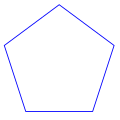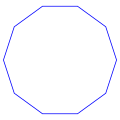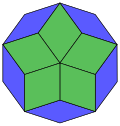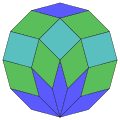Regular polygon
A regular polygon is a shape that can be drawn on a flat surface. It has sides that are all the same length, and its angles are all the same. In other words, a polygon which is both equilateral (which means all its sides have the same length) and equiangular (which means that all its angles are the same) is a regular polygon. It always has the same number of edges and points.
| Regular heptadecagon | |
|---|---|
 A regular heptadecagon | |
| Type | Regular polygon |
| Edges and vertices | 17 |
| Schläfli symbol | {17} |
| Coxeter diagram | |
| Symmetry group | Dihedral (D17), order 2×17 |
| Internal angle (degrees) | ≈158.82° |
| Dual polygon | Self |
| Properties | Convex, cyclic, equilateral, isogonal, isotoxal |
A polygon is also convex if there aren't any two points within it that can't be connected with a straight line, where the entire straight line is also in it. An example of a concave shape is a five-pointed star. It's concave because you can connect two of the points of a star with a straight line, and most of the straight line doesn't go through the star. If a five-pointed star is both equilateral and equiangular, it is also a regular polygon, but it isn't a convex one. All regular concave polygons are stars.
Examples
The simplest examples of regular convex polygons are:
Polygons with more sides look more like circles. A polygon with an infinite number of sides is called an apeirogon. Polygons can be described in text by a special symbol called a Schläfli symbol. This symbol is written as curly brackets, with some numbers inside it, like {3}. {3} is a triangle. The number inside can also be a fraction. A Schläfli symbol of {5/2} is a five-pointed star.
Properties
Most mathematical objects have things that can be said about them that are always true. These are called properties. All polygons (convex and star polygons) can be rotated in place by some angle and still look the same—in other words, they're all rotationally symmetric. For example, a square could be rotated a quarter turn, and it would look the same as before. Another way of seeing this property is that any polygon can have a circle drawn around it, touching all its points, and the polygon's points are evenly spaced around the circle. A polygon can also have a circle drawn inside it, touching all its edges (but not overlapping), and the places where the circle touches the polygon are also evenly spaced. The centers of the two circles drawn are in the same place. This proves that a regular polygon is rotationally symmetric.
The circle outside the polygon is called circumscribed, and the circle inside the polygon is called inscribed. Any polygon where a circle circumscribes all its points is called a cyclic polygon. All regular polygons are cyclic, but not all cyclic polygons are regular.
Regular Polygon Media
As a corollary of the annulus chord formula, the area bounded by the circumcircle and incircle of every unit convex regular polygon is π/4
Regular pentagon (n = 5) with side s, circumradius R and apothem a

















